


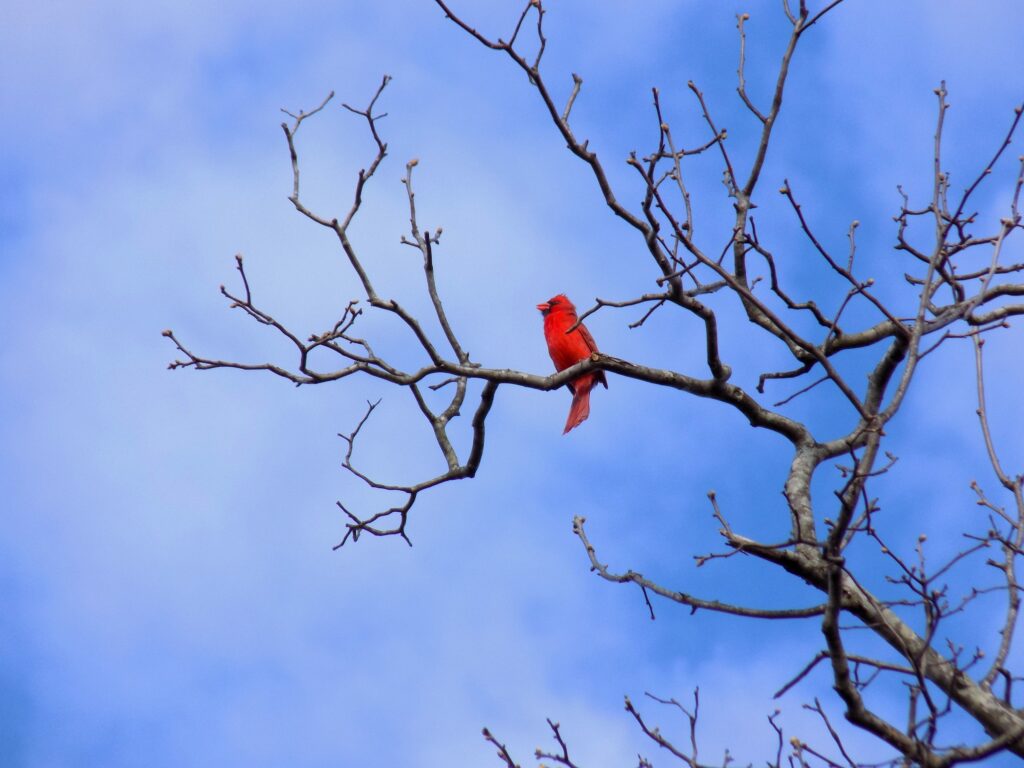
This week for Flora and Fauna Friday we have the unmistakable, unavoidable, scarlet songbird known throughout the eastern US. A bird that needs no introduction but will receive one anyway, the Northern Cardinal (Cardinalis cardinalis), or known more simply as the Cardinal or Red-bird.
Cardinals are an easily recognized, widespread species found in yards, brush, wood edges, and hedgerows from Maine to Minnesota to Guatemala. They don’t migrate and can be found throughout most of their range year-round, whether braving the winter or enjoying the summer. Male Cardinals are a deep, pure red and females a warm orange-brown with subdued garnet wings and tail. Both sexes sport a bold orange bill and black beard with a prominent crest to the head. They’re generalists, eating seeds, insects, worms, fruits, and nuts. Their stout bill allows them to take advantage of heavy seeds and the harder nuts to crack but it doesn’t limit their ability to eat softer, wrigglier foods. Cardinals are no strangers to bird feeders and regularly visit these seed dispensaries across this half of the continent. Like many feeder birds, they prefer sunflower seeds and enjoy suet. Males and females mate for life and are rarely far apart from each other. Males are territorial and can often be seen fussing at each other around feeders or singing 20 feet or more up in the trees each morning to stake their claim with the neighbors. Cardinals get their name from the male’s plumage. His scarlet feathers are the same shade as the robes and caps worn by the Catholic Cardinals.

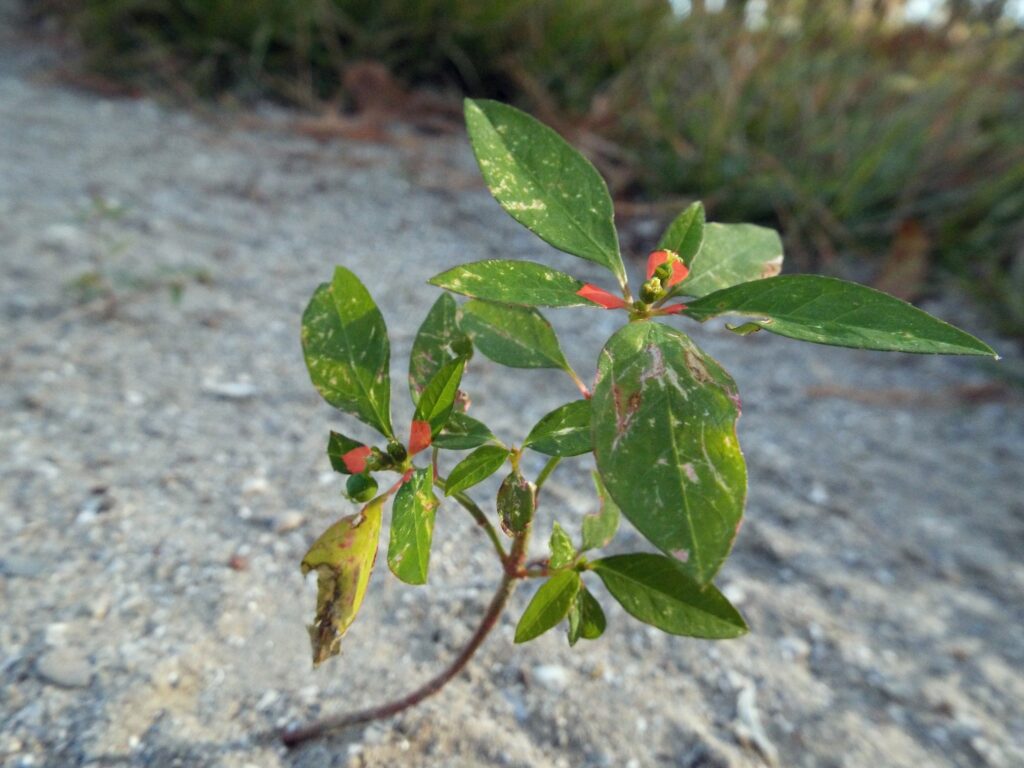

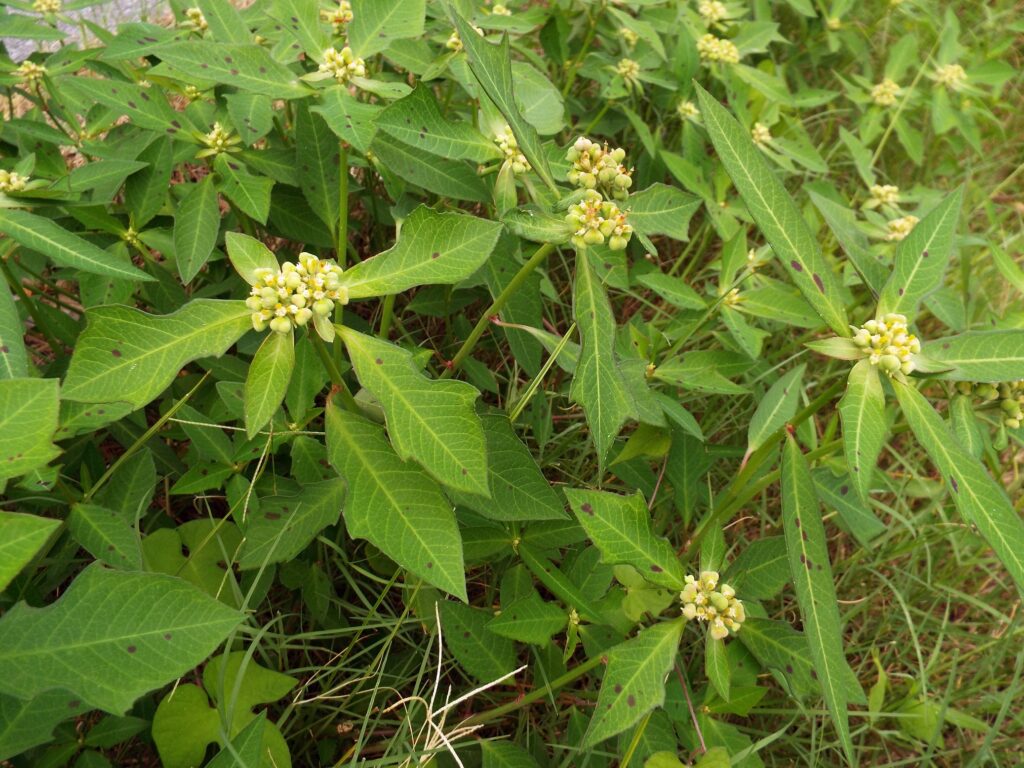
‘Tis the season for Flora and Fauna Friday because I have our native relatives of the crimson tropical trimming on display this holiday. This week we’re talking about Mexican Fireplant (Euphorbia heterophylla) and Fire-on-the-mountain (Euphorbia cyathophora), both who go by the name Wild Poinsettia.
Mexican Fireplant is a low-growing annual plant with large alternate leaves of variable shape. It’s in the same genus as the tropical ornamental Poinsettia (Euphorbia pulcherrima). It blooms in late summer producing a cluster of small, inconspicuous flowers above a ring of bracts, flecked with spots of red and a tinge of pink. Fire-on-the-mountain has more impressive crimson coloration to the bases of its bracts. It’s life history is much the same as Mexican Fireplant but with a greater tolerance for shade.
What’s interesting about the flowers of Poinsettias is that there are multiple layers of imitation going on. The red leaves of Poinsettias are bright, colorful, and draw in pollinators like petals but they’re not petals. They’re regular leaves modified to be colorful. So where are the petals? If you look closely at the central cluster, you’ll notice several pale yellow structures that look a lot like petaled flowers. However, the color you see is not the flowers themselves. Rather, they’re parts of a complex compound flower unique to the Euphorbiaceae family called a cyathium. The actual flowers are unisexual and lack both petals and nectar! The pale yellow structures that resemble petals are again modified leaves called bracteoles. Outside of these bracteoles you may notice a golden funnel shaped structure. That’s a nectar gland. Its sole function is to produce nectar for pollinators. The flowers themselves are located in two places. The tiny white stalks with two pink discs on the end are the male flowers. The three-sided lumpy ball hanging out of the middle of the male flowers is the maturing seed capsule and that small cone on the other side is the female flower. The cyathium is truly odd and unlike the flower of any other plant family. The next time you see a Poinsettia, appreciate the weirdness that makes it as beautiful as it is!

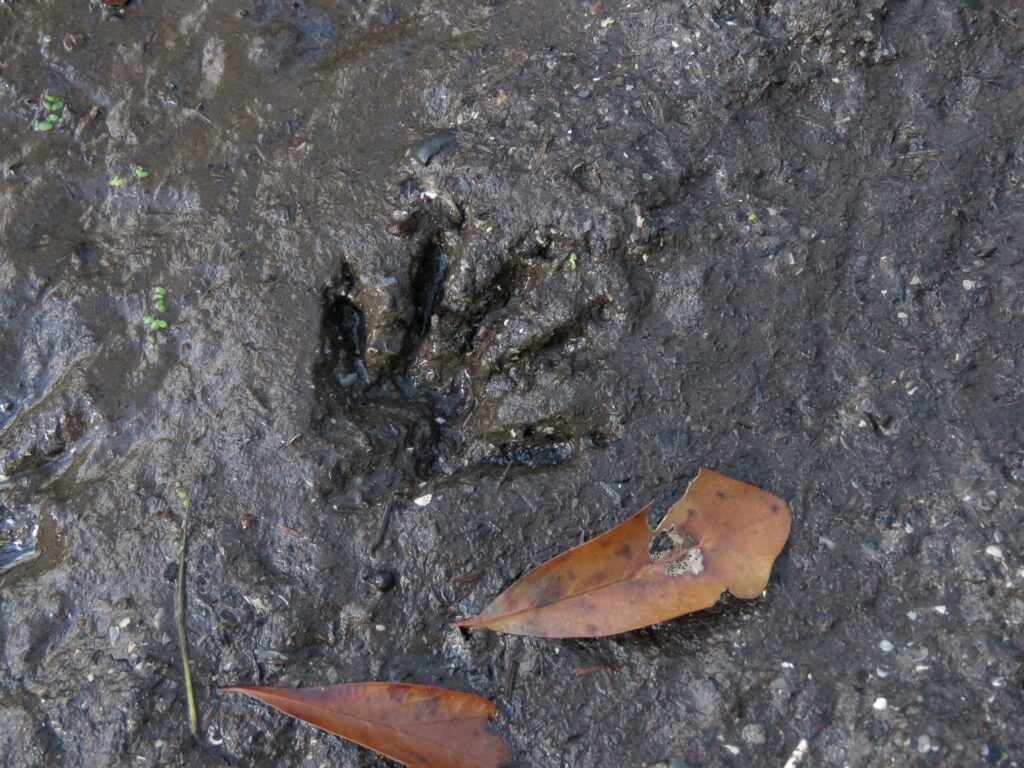
For Flora and Fauna Friday this week we have the banded bandit of the woods in our custody. No, that’s not Santa coming down the chimney it’s the Common Raccoon (Procyon lotor).
The Raccoon is an intelligent, dexterous, omnivorous, nocturnal, highly-adaptable, generalist mammal found throughout the US and Mexico. They are found in practically every habitat in the state, from barrier islands to mountain forests to bottomland swamps to the middle of the city. The average Raccoon here in the south is roughly the size of a house cat and weighs about 10 to 15 pounds. Their coat is a dark grayish-brown with a fluffy tail ringed by black bands. They have a black mask across their eyes and a pale gray snout, brow, and muttonchops. They have plantigrade feet, so their tracks look like little handprints. They belong to a small family, Procyonidae, that is most closely related to Bears and Weasels.
Raccoons have an interesting habit of dipping their food in water and rolling it around in their hands called “dousing”. The behavior looks like their washing their food but that’s not actually the case. In fact, biologists aren’t fully sure why they do this but believe it helps them soften their leathery paws and better feel the texture of what they caught. They primarily douse when hunting aquatic animals and won’t bother dousing if there’s no standing water around. Raccoons have long limbs, dexterous paws, and short stiff claws that make them excellent tree climbers. Climbing a tree is a Raccoon’s primary defense against predators. They also sleep through the day in a tree hollow or the crook of a tree limb. Raccoons are most active at night where they patrol their territory hunting frogs, fish, fiddler crabs, bird eggs, and crawfish and eating any berries, nuts, or seeds they may find. They will scavenge carrion too and raid farm fields for vegetables. In urban areas, they also pilfer bird feeders, steal pet food, and scavenge from trash cans. Raccoons are known for their intelligence and studies indicate that they’re as smart as some of the lesser primates. Their intelligence and dexterity, combined with their omnivorous diet, makes them highly adaptable. They’re one of a few native species that have taken to urban life with a shine. They can quickly learn how to undo latches, open closed containers, scale buildings, and remember who in your neighborhood feeds an outside cat, has a fig tree in their backyard, throws out half eaten pizza, or has a hole in their attic.
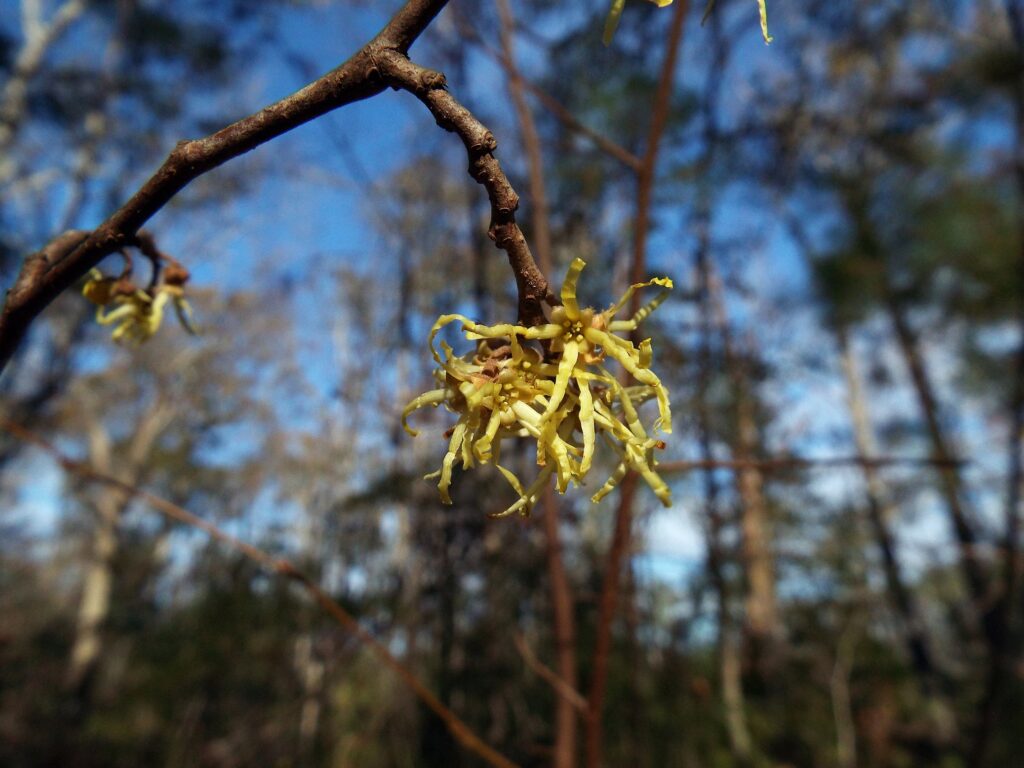
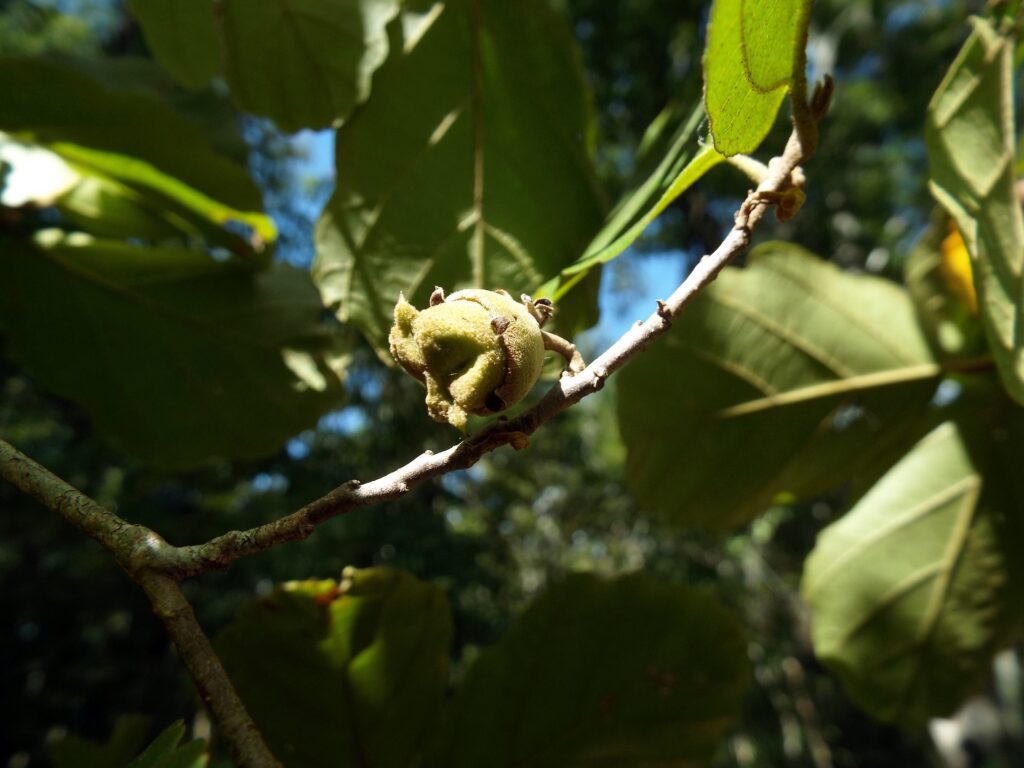

This week for Flora and Fauna Friday, we have an explosive and medicinal shrub that can be found flowering in the winter woods. This week we’re talking about American Witch-hazel (Hamamelis virginiana).
Witch-hazel is a large open shrub that grows in the understory of hardwood forests. It has fairly large, oval-shaped, deciduous leaves with a crenate (scalloped) margin. Its bark is thin with a light tan to gray color. Witch-hazel blooms in late Fall and here on the coast it’s one of the last plants to flower. The flower is fairly small with four pale-yellow and curly, ribbon-like petals. The fruit is a capsule with four bumps on top, like the scores in a loaf of bread, that cradle the two seeds within. Many of you likely know of Witch-hazel from its medicinal applications. Witch-hazel bark, stems, and leaves can be boiled to extract astringent compounds that can contract the skin and help relieve mild skin irritation. However, most modern concoctions are lacking in this traditional plant derived astringent.
Witch-hazel fruits remain on the shrub for a full year. Come autumn, they undergo an amazing process. The walls of the fruit grow asymmetrically at the cellular level. As it dries, this causes the wood of the fruit to bend outward. The water pressure from living cells is no longer there to retain the shape. These fruits are dehiscent too, meaning they have natural seams to allow the fruit to split as it dries. Neither of these two features are especially unique in the plant word and many species can do both. What is unique are the extremes to which Witch-hazel takes them both and the result it produces. The seams of this fruit are particularly strong and the asymmetry even stronger. As the fruit dries, the walls of the capsule put more and more pressure on the seams, creating a natural spring-loaded cannon. The spring pressure increases until a gust of wind, beam of sun, or some other disturbance causes a seam to fail and the whole fruit to split apart with an audible snap, kicking the seed out from the bottom in the process. This is called “explosive dehiscence” and it can throw the centimeter-long Witch-hazel seeds up to 30 feet!
It wouldn’t be Flora and Fauna Friday without me playing the explain the name game. So where does Witch-hazel get its interesting common name? It’s not that exciting. The plant looks similar to the true hazels, which produce hazelnuts, and “witch hazel” simply means “pliable hazel” in Middle English. However, a more interesting and completely false interpretation that I’m going to tell you anyway is that it comes from the galls that a certain species of aphid produces on its leaves. The Witch-hazel Cone Gall Aphid (Hormaphis hamamelidis) lays its eggs on the leaves of Witch-hazel. These eggs hatch into larvae that secrete chemicals into the tissue of the leaf. This tissue induces an abnormal growth on the leaf surrounding each larva. The larva feeds on the regenerating tissue inside of this growth while safe from the elements. This growth is called a gall and it’s a parasite’s way of fooling a plant into feeding its offspring. The galls of the Witch-hazel Cone Gall Aphid are conical in shape and poke out from the top of the leaf. This gives the leaf a shape similar to a witch’s hat, except with an over exaggerated brim width. That etymology isn’t true but I wanted an excuse to talk to about leaf galls.
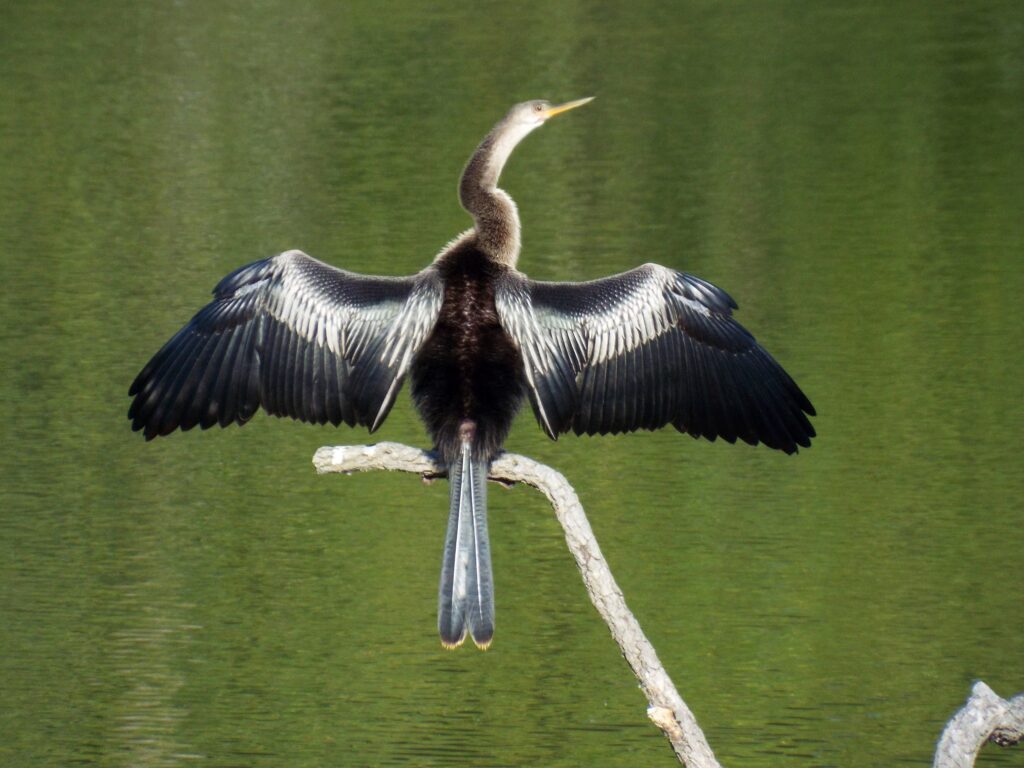
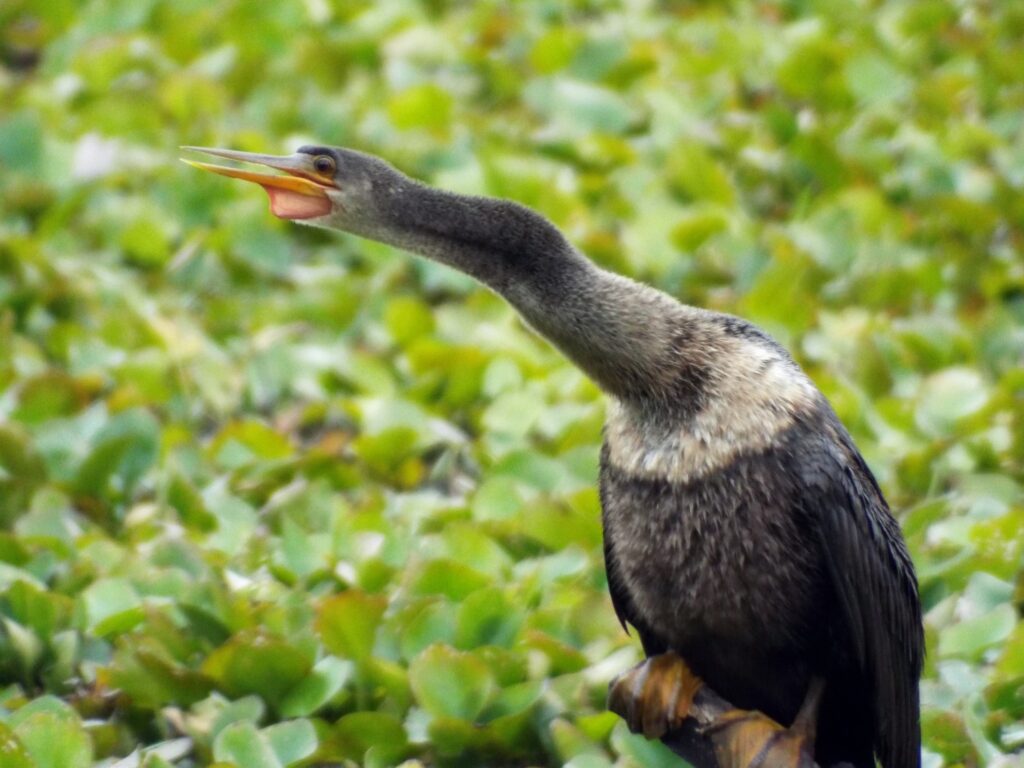
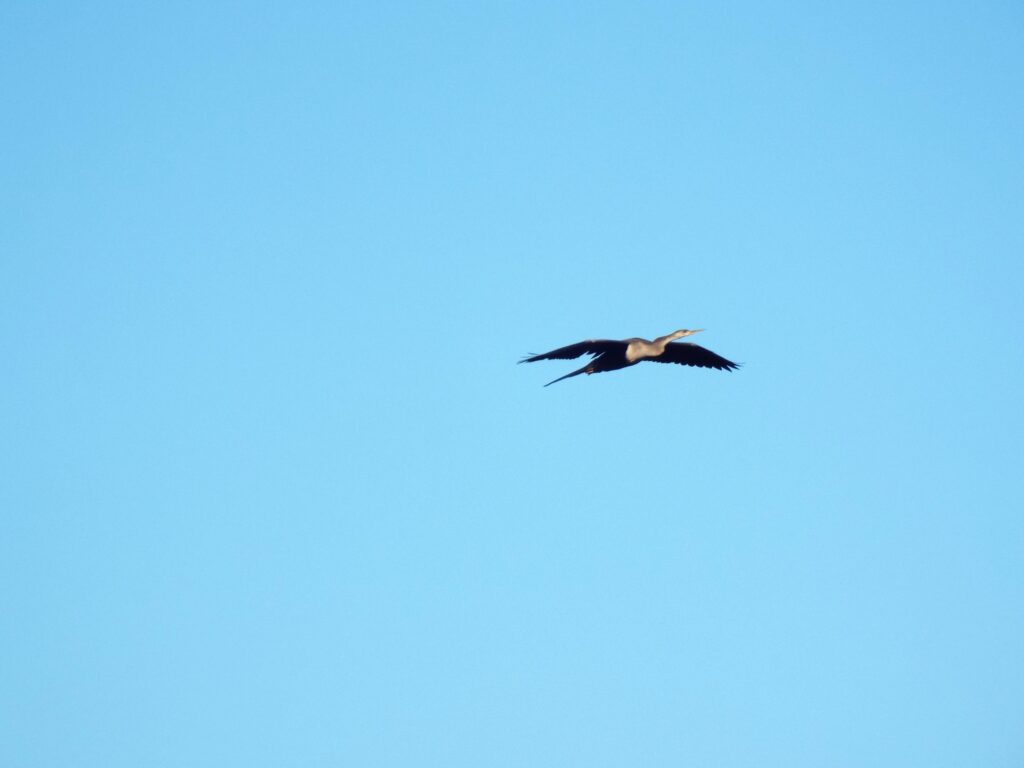

This week for Flora and Fauna Friday, we have a one of a kind, snake-necked, needle-nosed, neutrally buoyant bird. Today we’re gawking at the Anhinga (Anhinga anhinga) family Anhingidae. Also known as the American Darter, Snake-bird, or Water-Turkey. The word “Anhinga” comes from a native Brazilian dialect and means snake/devil bird.
Anhingas are weird, but in a good way. The Anhinga is found throughout much of South America and the coastal plain of the southern US. They’re most closely related to Cormorants and Gannets. Anhingas have a long neck, fan-like tail, webbed feet, and large wings. Their feathers are a deep-brown or black on the body, silvery-gray and black through the wing, and a creamy-tan on the throat and chest. During breeding season, males turn jet black throughout with blonde highlights on their crown and a turquoise eyespot. When soaring through the sky, they can resemble Bald Eagles from a distance. Anhingas are piscivorous. They hunt and eat only fish. Their bodies are very well adapted for this lifestyle and it’s also what makes them as weird as they are.
Anhingas are the spear-fishermen of the bird world and everything about them is suited to that task. Their eyes face forward, giving them great binocular vision. Their bill is needle-like, perfect for poking clear through a Bass. Their neck is long and S-curved, allowing them to speedily spear fish. They have a stretchy, membranous throat that aids in swallowing fish. Their feet are wide and webbed, providing rapid propulsion and course correction. Their tail is long and broad, working like a stabilizing fin to adjust pitch and prevent roll. Most interestingly of all, their feathers don’t repel water. Water does not run off this odd duck’s back. Most aquatic birds have a hydrophobic coating to their feathers that traps an insulating layer of air beneath them. This makes a bird buoyant and keeps it warm and dry in cold water. Fighting against buoyancy is exhausting work and it makes a bird less stealthy and impairs agility. In contrast, the Anhinga forgoes this approach entirely. Their feathers wick up water and don’t hold any air. This can make their feathers look more like fur than feathers. It’s also how they get the name snake bird. Since their bodies sink below the surface of the water, all you can see of a swimming Anhinga is its long serpentine neck craning out of the water. When Anhingas depart the drink to rest and digest, you’ll see them perched, neck outstretched, wings held wide to the sun. They pose this way to allow water to run out of their feathers so their plumage can air dry. Their lack of aquatic insulation means Anhingas are mainly a tropical species. However, they summer here in the southern US and some stay year-round in areas where the water temperatures stay warmer.
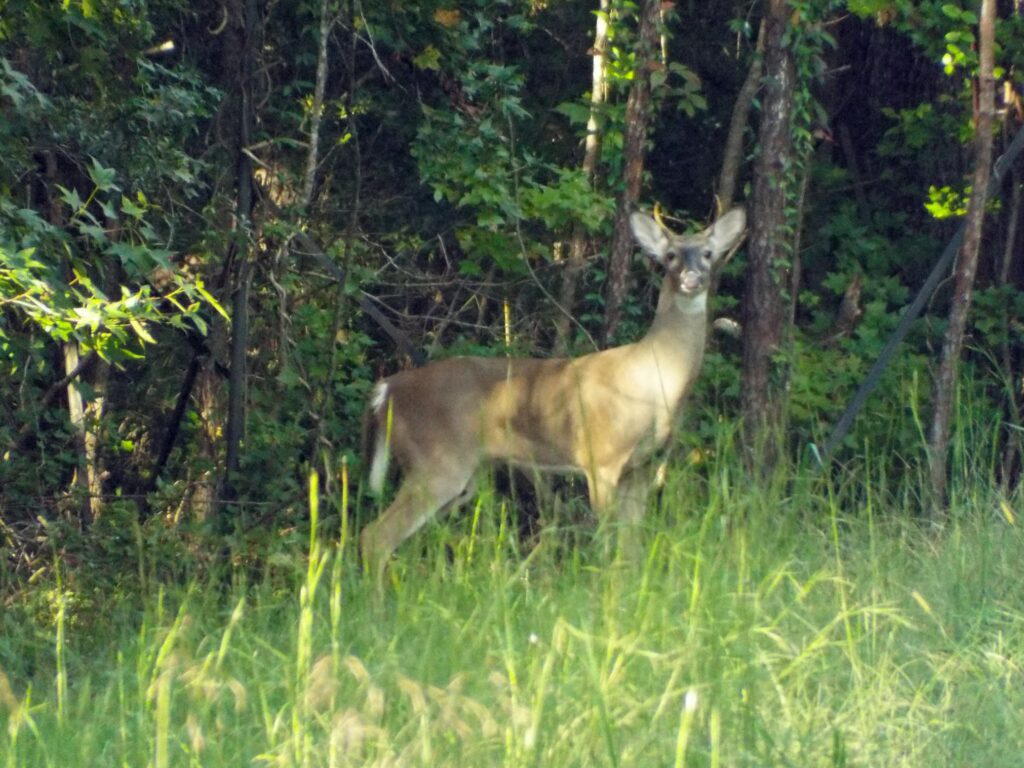
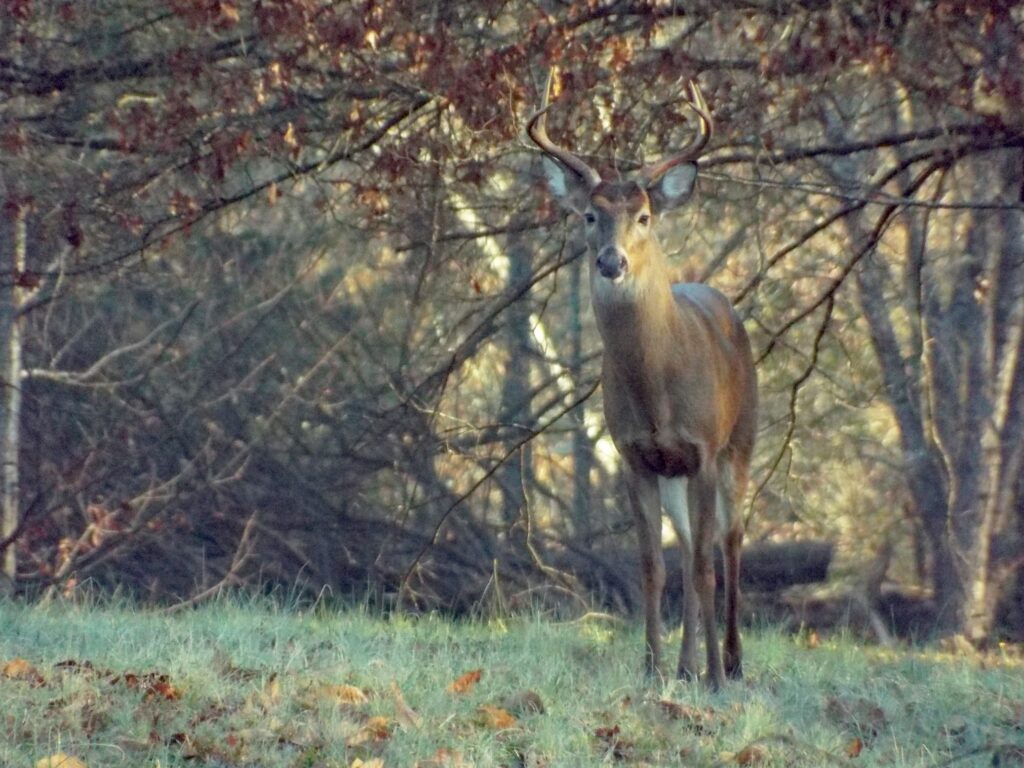
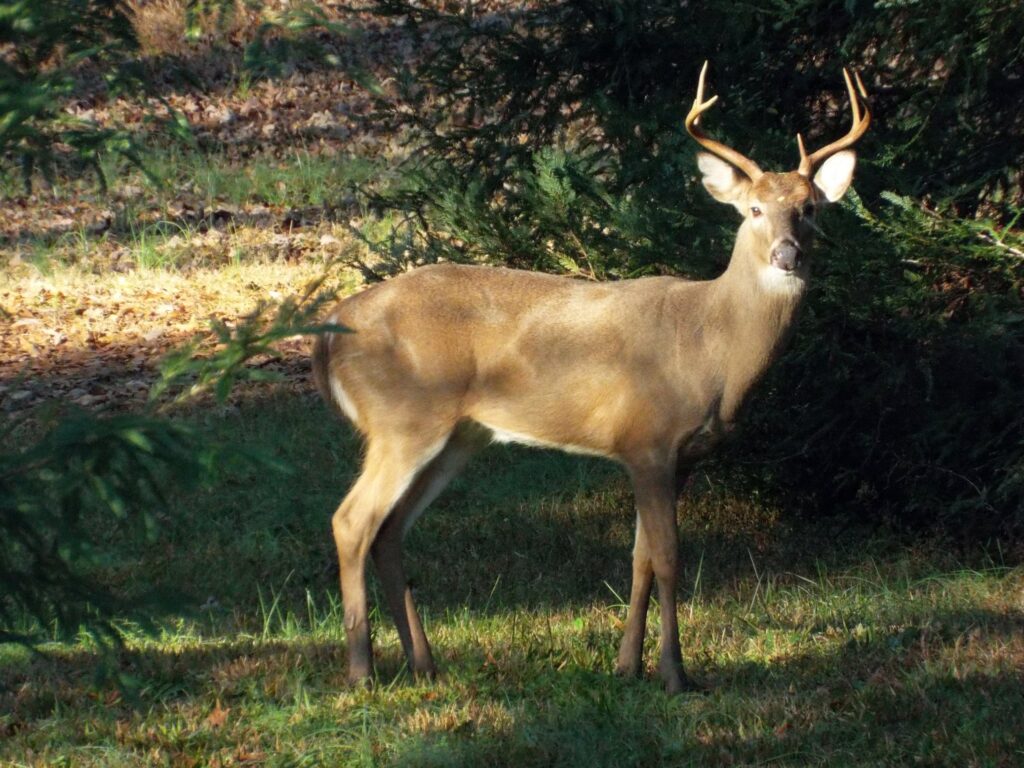
This week for Flora and Fauna Friday, we have a ubiquitous ungulate from across the US. This week we’re taking a gander at the White-tailed Deer (Odocoileus virginianus).
Found everywhere in the United States and Mexico, except the arid southwest, the White-tailed Deer is North America’s most common native ungulate and the only species of ungulate native to Edisto. They are a highly adaptable species found in every terrestrial ecosystem in SC. The subspecies we have inland and here on Edisto is the Southeastern White-tailed Deer (Odocoileus virginianus virginianus). Ungulates are a group of mammals who walk on hooves and whose legs are shaped differently because of it. There are three main classifications of mammal legs, unguligrade, digitigrade, and plantigrade. I’ll explain each of them by how many joints they have in their foot. Humans, bears, opossums, rats, and raccoons are plantigrade. We walk on the heels, balls, and toes of our feet. Dogs, cats, and birds are digitigrade. They walk on just the balls and toes of their feet. Deer, cows, horses, antelopes, and pigs are unguligrade. They walk only on the tips of their toes. A hoof is really just a big toenail!
While we’re on the topic of pedantic biological terminology, members of the Deer family, Cervidae, have antlers. Antlers are a unique feature of the family. They are made of solid bone and attached to the skull by a structure called the pedicle. Except for Caribou, only male deer have antlers and they are shed in late winter each year. In contrast, the horns of cattle and antelope have a hollow bony core coated in a thick layer of keratin, the same substance that makes up their hooves and hair, and horns are not shed but grow continuously. Male deer, called bucks, use their antlers to settle territorial disputes during the rut. The rut is the species’ mating season and bucks become increasingly aggressive and single-minded, forgoing eating and sleeping to fight and mate. They go antler to antler with other bucks over territory and mating rights. Only the strongest and most well fed will prevail. A buck will also use his antlers to defend against predators and to mark his territory by rubbing them and the scent glands on his forehead against small trees. Shed deer antlers are an important source of calcium and phosphorous for some species of wildlife. Rats, mice, rabbits, snails, and Squirrels will rapidly gnaw away at shed antlers as soon as they hit the forest floor. If you’ve ever wondered why you don’t find years’ worth of antlers littering the woods, that’s why!
The White-tailed Deer has been a culturally significant animal in the Southeast as long as humans have lived here. Native Americans on the coast hunted them not just for their meat but for their hide, sinew, and bone. Materials critical for making clothes, bow strings, and tools. White-tailed Deer were an important food source for colonists in early America and for both freedmen and white southerners alike in the financially destitute South after the Civil War. Today, that hunting tradition is still alive and well. Although it’s no longer a dietary necessity for most hunters, the hunting of White-tailed Deer is just as important for wildlife conservation today as it was for the survival for early Americans. White-tailed Deer have lost almost all of their natural predators in the southeast. Cougars and Red Wolves have been extirpated from South Carolina and our Black Bear populations are sparse and isolated. Although a bull Alligator is more than capable of taking a mature Buck, Alligators rarely attack deer. ‘Gators simply have easier prey to hunt. Bobcats and Foxes will hunt fawns. Coyotes fill some of this niche by hunting weak deer and fawns but aren’t large enough to hunt healthy adult deer alone. In rare instances, Coyotes will hunt in packs and are capable of taking mature deer but this is not a common occurrence. Left uncontrolled, deer populations quickly grow to the carrying capacity of the land and induce ecosystem-wide alterations in plant communities by overgrazing their preferred food plants. This continuous and selective plant grazing alters the plant community and, in turn, changes the habitat composition of the area. The habitat composition determines what species of wildlife can live there. These disturbances in the plant community also open up chances for invasive species to establish and further degrade the habitat. White-tailed Deer are generalists and are mostly unfazed by this habitat change. More specialist species, typically rarer and of great concern to conservationists, are pushed out of the habitat and, in extreme cases, may never be able to return. This process is called a “trophic cascade”, an ecological positive-feedback loop that can be devastating to an ecosystem. Luckily, deer hunting prevents this and SCDNR manages White-tailed Deer across the state in excruciating detail to prevent this on public lands. Additionally, the sale of hunting licenses, deer tags, sporting arms, and ammunition provides the lion’s share of funding for all conservation work that happens in this state. That’s funding for all conservation work for all species, not just game species.


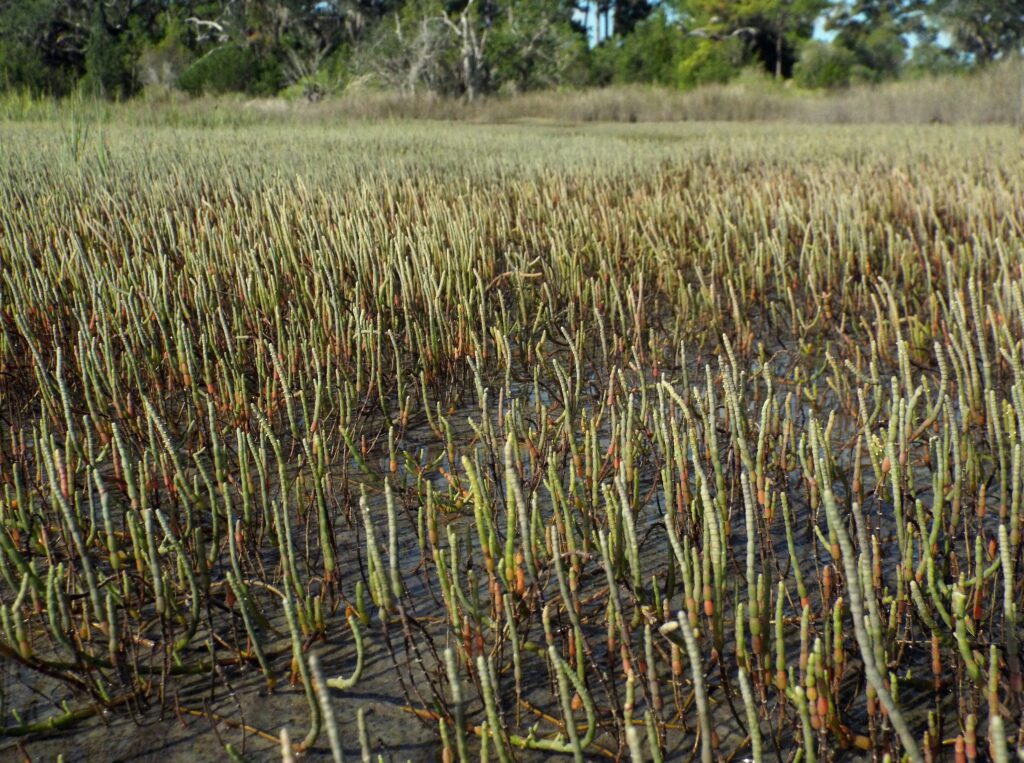
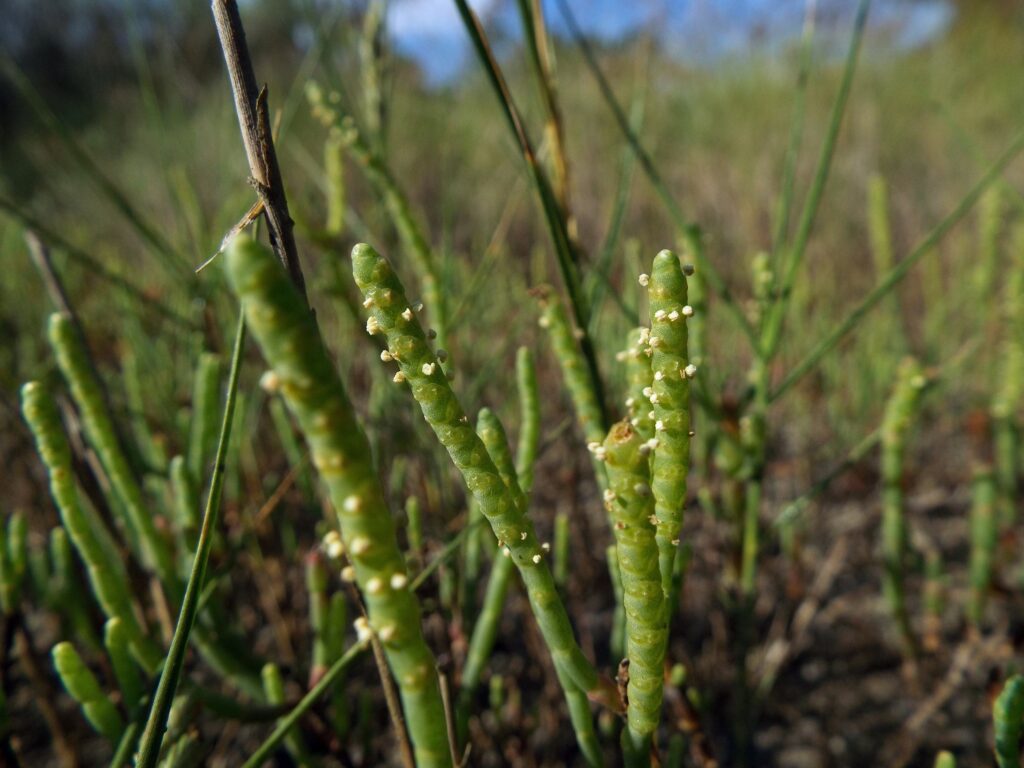
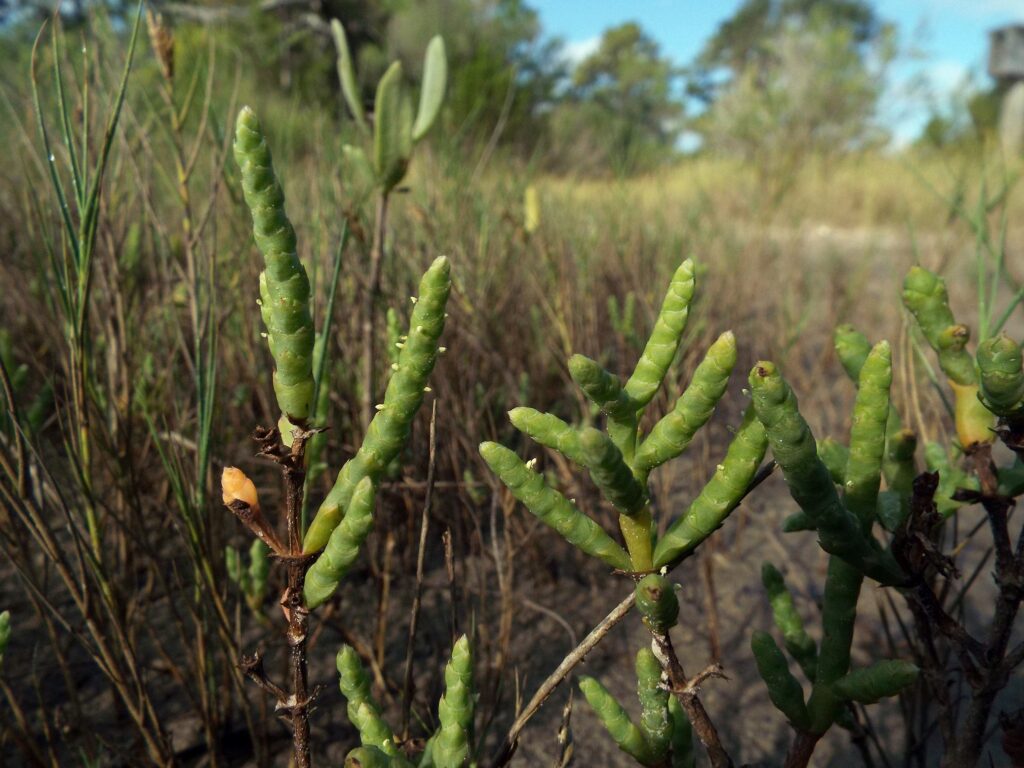
This week for Flora and Fauna Friday, we have an edible, pre-seasoned, halophytic plant on the menu. This week we’re talking about the Glassworts, Genus Salicornia.
Glassworts are a clade of salt-loving succulent flowering plants that grow best in the sandy soils of salty wetlands in the subfamily Salicornioideae. Here on Edisto, you’ll find them on the sand flats of the high saltmarsh. Their succulent leaves are oppositely arranged but wrap entirely around the stem of the plant, giving Glassworts a jointed, somewhat cactus-like appearance. These leaves are packed with salts the plants accumulate from the saline tides that bathe them twice a day. The Glassworts get their name from this salt-sequestering ability. In England during the renaissance era, it was discovered that these plants could be harvested and burned to produce soda-ash, an important ingredient in glass making. Glassworts are also edible and can be eaten raw or cooked. They are predictably quite salty, which has granted them the common name Pickleweed. The plants can be grown on land where little else grows and irrigated with saltwater and agricultural runoff. Glassworts are rich in fats and protein and can be harvested as animal feed or converted into biofuels. Species in the genus Salicornia also serve as hosts to our smallest species of butterfly, The Eastern Pygmy Blue (Brephidium pseudofea).
Here on Edisto I believe we have two species of Glasswort, Dwarf Glasswort (Salicornia bigelovii) and Perennial Glasswort (Salicornia pacifica). I’m not sure how many species we have because this group of plants is in taxonomic turmoil at the moment. I can’t find a scientific consensus on the phylogenetics and I’m not entirely sure there is one at this point. So we’ll just go with my best guess. Dwarf Glasswort is an erect annual species with a bare stem towards the base and highly swollen leaves. It turns a bright orange red in fall before dying off in the winter. Virginia Glasswort is a prostrate, spreading perennial species. This is the more common species you’ll see in the saltmarsh and the one that will form stands that blanket the sand.

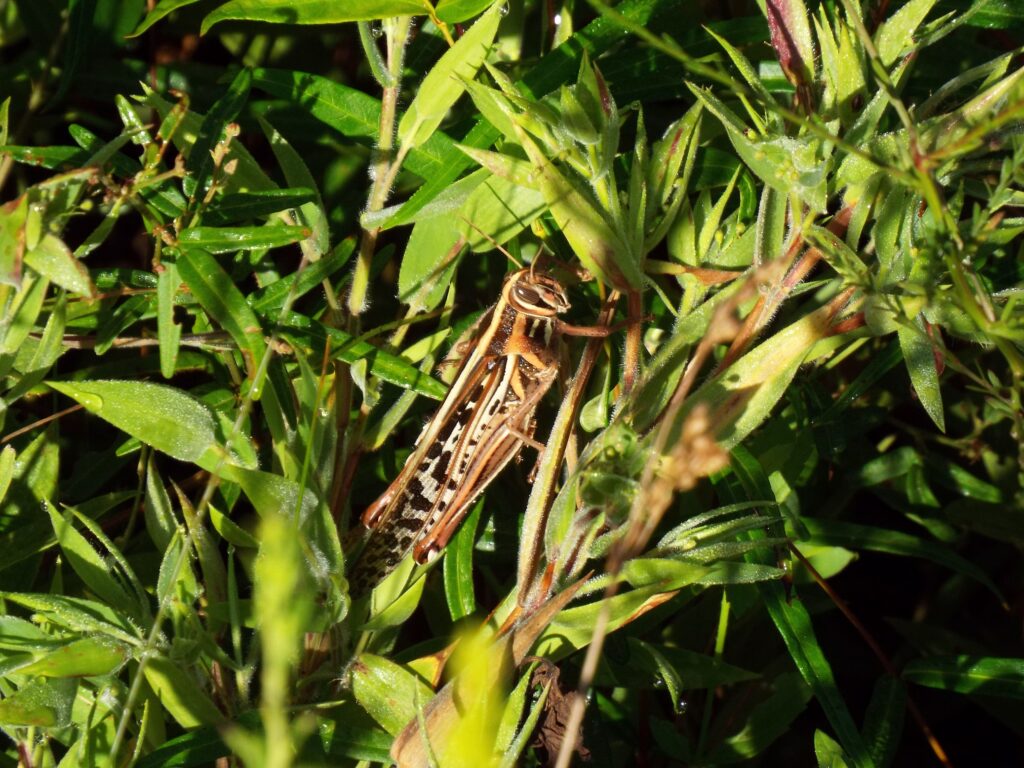
This week for Flora and Fauna Friday, we have an acrobatic arthropod of avian proportions. This week we’re talking about the American Bird Grasshopper (Schistocerca americana).
The American Bird Grasshopper is a very large grasshopper, with females reaching nearly 4 inches in length. Their color is primarily a golden tan, mottled with brown and black, and topped with a tan stripe down the center of the back. They can be found in fields, meadows, and prairies feeding on grasses, forbs, and the leaves of broadleaf trees. American Bird Grasshoppers get their name not only from their substantial size but because of their unique behavior when fleeing as well. When disturbed, they will leap from their perch and take flight. Instead of quickly throwing themselves back into the safety of the grass, like other grasshoppers, the American Bird Grasshopper will soar up into the air before either landing atop grass some yards away or lazily flying up into the branches of a tree to hide. Much like a flushed bird would do. Their substantial size and lackadaisical flight behavior makes them a target for predators. They’re a favorite food for the Loggerhead Shrike and American Kestrel, who’ll snatch the insects out of the air.
Our species is in the same genus as the swarming Desert Locust (Schistocera gregaria), infamous from the biblical plague. Although the American Bird Grasshopper can be considered a pest to some agricultural crops, it doesn’t swarm like its Old World cousin. Swarming is an adaptation to life in the desert, where food is scarce and scattered over vast distances. That’s not the case here in the southeastern United States. The American Bird Grasshopper is content with dining alone in the bounty of our climate. Adults overwinter and can often be seen rousing in fallow fields and meadows on warm winter days. Come Spring and Summer, the new year’s generation emerges to carry the species’ mantle.

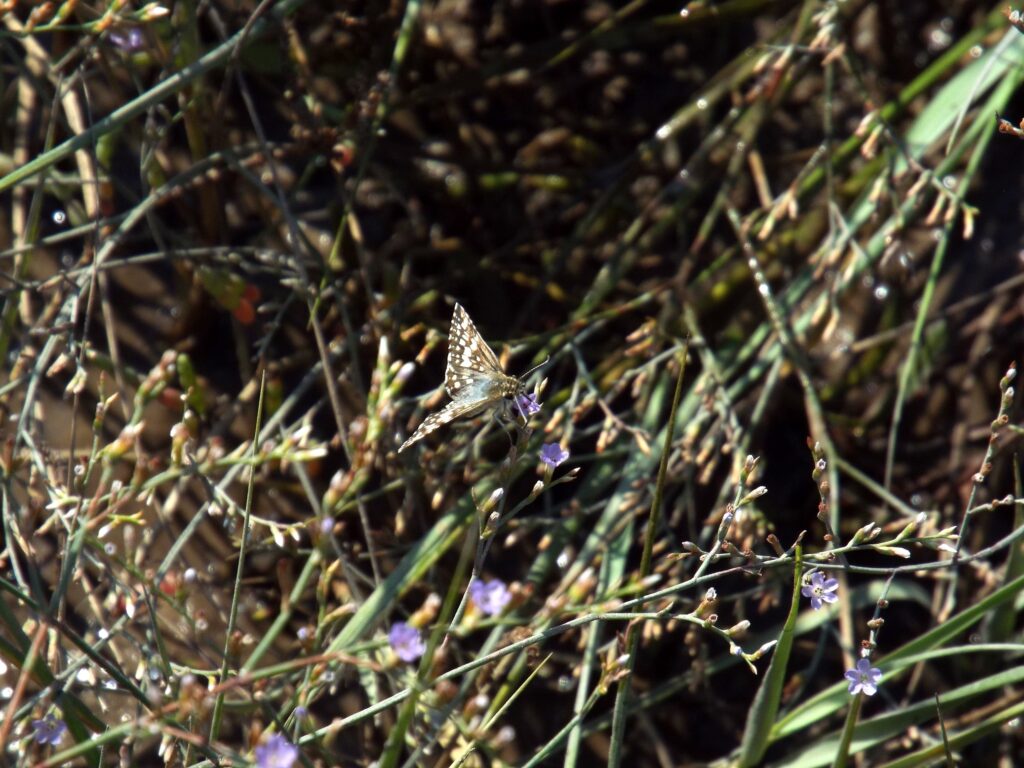
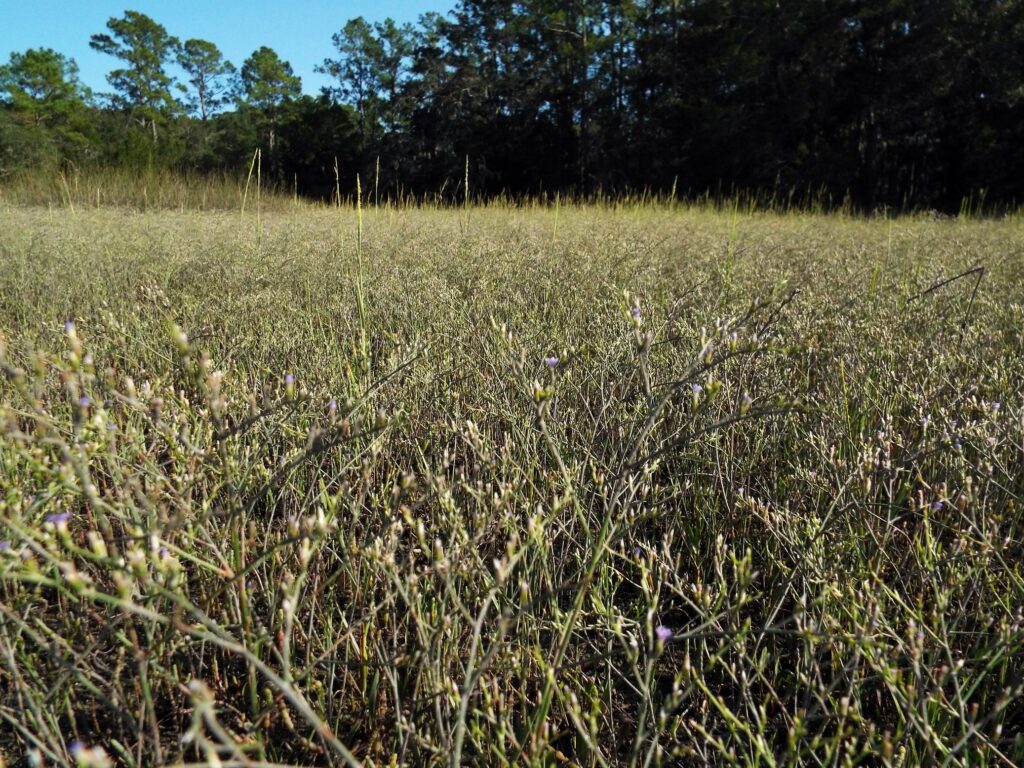

This week for Flora and Fauna Friday, we have a wildflower of the high saltmarsh. This week we’re looking at Carolina Sealavender (Limonium carolinianum).
Carolina Sealavender is a perennial wildflower that can reach two feet in height. It’s found exclusively in the saltmarsh, growing in the high marsh along the edges of sand flats. Just outside the meadows of Fimbry and Rush. It’s one of a select few plants that tolerate the harsh life in the saltmarsh and one of the fewer still that sport flowers. A breath of beauty in an oft barren plain. For most of the year it exists as a rosette of simple leaves above the bare sand of the marsh. In summer and fall, Sealavender blooms producing a web of stems punctuated by lavender flowers. Each flower has 5 petals and is less than a quarter of an inch across. What these flowers lack in size they can make up for in the intensity of their color, as well as their volume. Their inflorescence forks in a fractal manner and each arm ends in a line of bright purple flowers. After the flowers dry and the seeds mature and disperse, the flower stalks remain. They can be seen along the marsh edges for months afterwards. Like miniature dormant trees in a fallow winter’s field of salted sand.
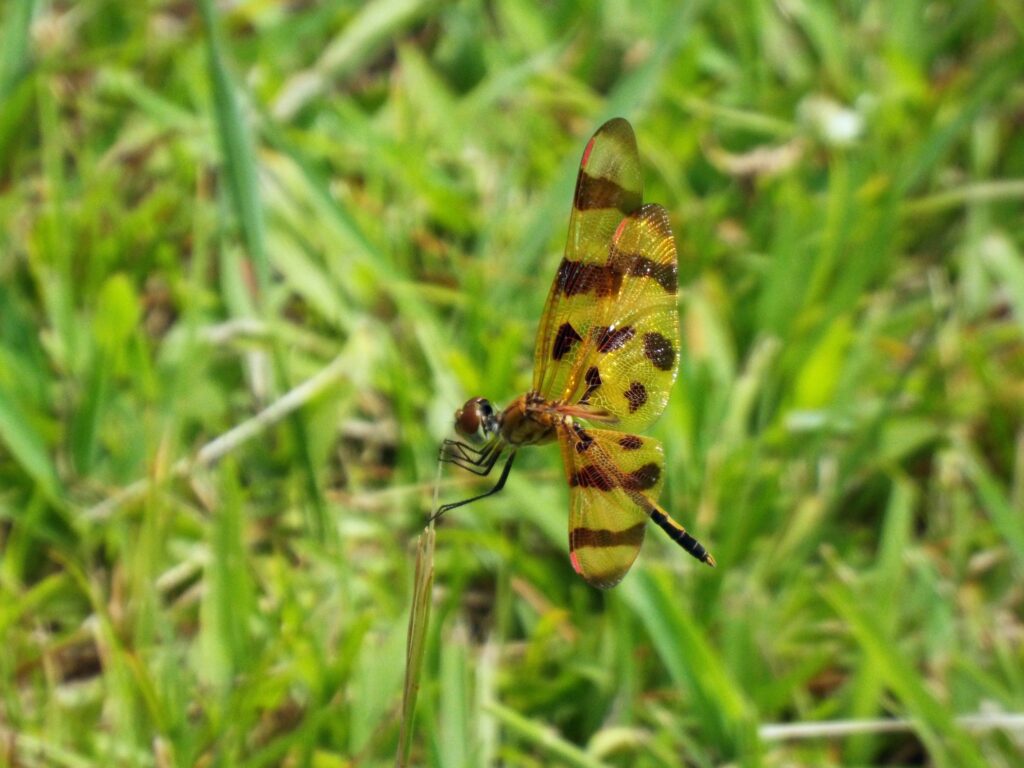

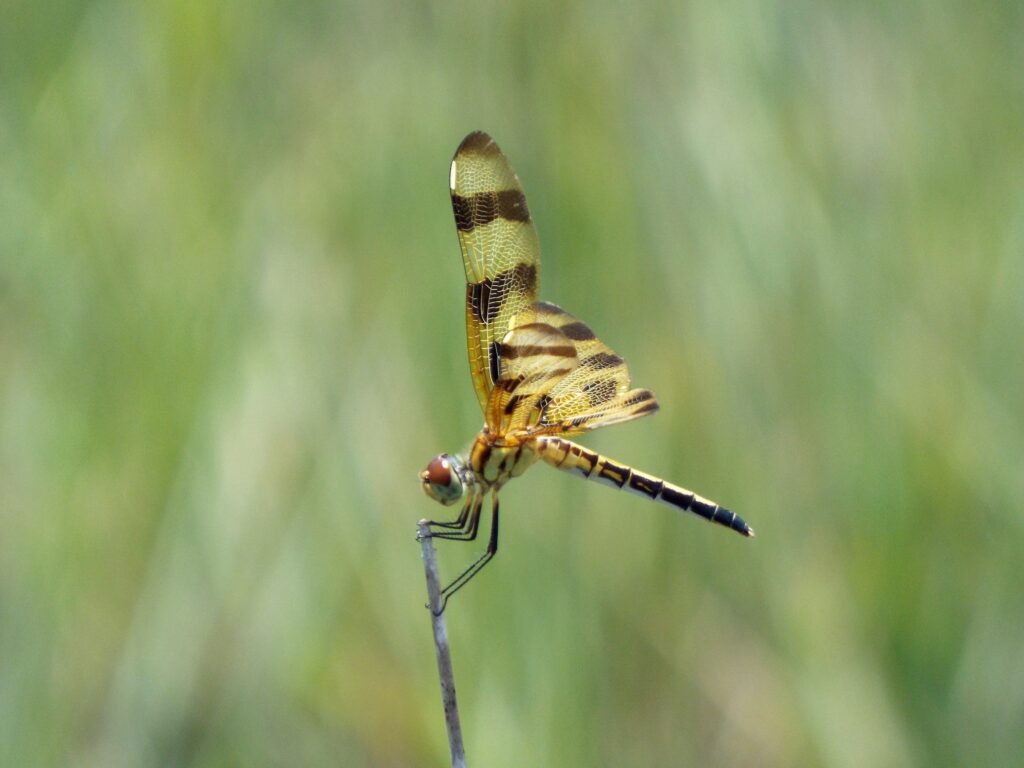
For this week’s Halloween special edition of Flora and Fauna Friday, our subject is neither ghoulish nor haunting but aptly named. The cold moon’s light of Hallow’s Eve shines upon the Halloween Pennant (Celithemis eponina).
The Halloween Pennant is a medium-sized dragonfly in the Skimmer family, Libellulidae. Although named for the fall holiday, the Halloween Pennant is most easily observed in summer. It breeds in marshy ponds and wetlands. It typically hunts in fields and high saltmarsh where it can often be seen perched on the tip of a grass blade, watching for prey. Male Halloween Pennants aren’t territorial like other dragonfly species and won’t be seen chasing each other through the air. Conversely, they are rather protective of their perch and will brush off harassment from larger, more territorial dragonfly species in favor of keeping their seat. Halloween Pennants have abnormally long wings for their body size compared to most dragonflies. This lends them a floaty flight pattern more like a butterfly than other Skimmers and Pennants. They get their autumn-themed moniker from the color of the male’s elongated wings. His wings are a transparent burnt orange striped with thick bands of ebony brown and coral red veins that bring to mind the orange and blacks of Halloween décor. Females are just as colorful with bright yellow wings banded with black. The wings of the male are studded at the tips with hot pink stigmata. The female’s stigmata are cream white. Stigmata, or more accurately pterostigmata, are distinct cells on the leading edge of the wing near the tip. These cells are thickened areas of chitin that are opaque and colored in many species of dragonfly, making them stand out from the rest of the wing. The dense pterostigma improves the aerodynamics of a dragonfly wing by reducing vibrations and allowing dragonflies to glide at faster top speeds.